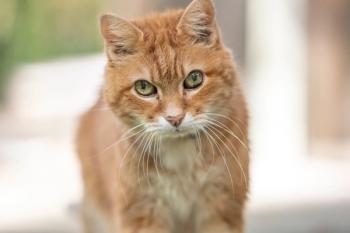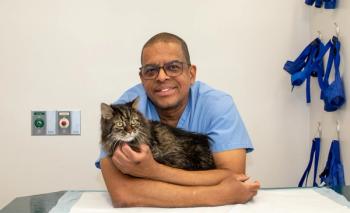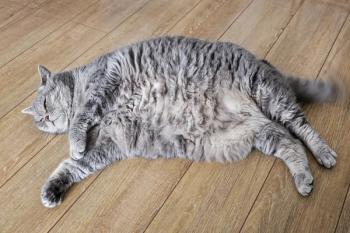
To save cats: Why practices should maximize preventive care
Veterinary teams can improve patient health and the practices bottom line by focusing on preventive care, according to this educator at last year's American Association of Feline Practitioners conference.
(Shutterstock.com)
“Can we increase our revenue by offering what cats deserve?” Dr. Christine Bohn Kirnos of the Cat Hospital of Media asked at the American Association of Feline Practitioners (AAFP) conference last year. “The answer is yes.”
During her lecture, Dr. Kirnos discussed how developing preventive care guidelines for senior cats can improve revenue for veterinary hospitals.
Missed opportunities
Veterinarians are well aware of the declining revenue from feline visits. Dr. Kirnos identified two main reasons for this decline: a decrease in the overall number of cat visits and a large gap in spending between cat and dog owners.
“The number of cats kept as pets is going up, and that's great,” said Dr. Kirnos. “However, the number of veterinary visits is down.” The
Stress of veterinary visits for both cats and their owners
Difficulty in transporting cats to the veterinary clinic
Lack of client education, as pet owners believe cats are self-sufficient and do not need care or do not notice signs of illness due to the cat's ability to hide disease.
Organizations such as the AAFP and the CATalyst Council have focused on client and veterinary team education to increase veterinary visits by addressing these concerns. They provide resources such as tips for transporting cats, low-stress handling in the clinic, recognizing signs of illness, and the importance of preventive care. Despite these efforts, the number of visits continues to decrease.
While increasing the number of feline visits is certainly important, Dr. Kirnos suggests that veterinary teams can make a larger impact on their bottom line by focusing on the second problem: “People who own cats spend considerably less than they do for the other species. The difference is kind of staggering.”
According to the 2012 U.S. Pet Owner Demographics Sourcebook,2 average spending on feline patients is lower than that of canine patients. Mean veterinary expenditure per visit for cats was $107 less when compared with dogs. Dr. Kirnos identifies this gap as “a huge growth opportunity that we have in our practices.”
Designing a preventive care program
Historically, veterinary visits were driven by examinations and vaccines, but “we need to get away from that mindset,” said Dr. Kirnos. “In order for our practices to grow and be economically sustainable, we have to start thinking outside of exam and vaccines.” She encourages veterinarians to ask what more they can offer patients to maximize their care. The answer lies in preventive care.
Preventive care guidelines are meant to be a gold standard of care and function as standard operating procedures (SOPs) within the clinic. These are not the same as wellness packages, which are beyond the scope of Dr. Kirnos' lecture. “The goal of this is to provide a consistent message” that should come from all members of the team. SOPs should be customized to meet each clinic's gold standard of patient care. Not all clients will be able to do everything on the list, but the key is to have a plan in place to offer these items at each visit.
These SOPs are best developed by a team of individuals, including clinic leadership, associate veterinarians, front desk staff supervisors, technician supervisors, and other staff members with a strong passion for cat care. This group should work together to design guidelines for preventive care that they can present to the entire team.
Dr. Kirnos suggests the following questions to guide development of preventive care guidelines:
Does this plan meet the practice's mission statement and vision for patient care?
How do you define the target age group for your plan?
How often should examinations be performed?
What are your vaccination protocols?
What laboratory tests do you offer, and how often should they be performed?
What nutritional recommendations do you consistently make?
What medications and preventive products do you want to offer to each patient?
Dr. Kirnos states that there are no right or wrong answers to these questions, and the answers will vary by clinic. As an example, Dr. Kirnos reviewed her clinic's senior cat SOP. For the Cat Hospital of Media, senior cats are defined as cats over the age of 7 and the following recommendations are made:
Physical examinations every 6 months until the cats reach the geriatric life stage
Laboratory screening every 6 months that includes a complete blood count, chemistry panel, total T4, urinalysis and fecal
Blood pressure screening every 6 months
Annual rabies vaccination
3-year FVRCP vaccination
Other vaccinations and FeLV/FIV testing recommendations based on lifestyle
A nutritional recommendation at every visit
Year-round parasite prevention
Dental recommendations at every visit that are proactive, starting at grade 1 or 2 periodontal disease.
There are numerous existing resources that veterinary teams can utilize in developing their own preventive care SOPs. Dr. Kirnos recommends reviewing the
Implementation of preventive care guidelines
Once preventive care guidelines are developed, they should be presented to the staff. It is essential that the entire veterinary team be on board with the guidelines from the beginning. Dr. Kirnos stresses the importance of consistency for clients, saying, “If the doctors are similarly like-minded and giving the same consistent recommendations […], the client is more likely to take those recommendations.” These recommendations can be further reinforced by support staff from the front desk to the technicians.
It is important to have an open discussion with team members prior to implementing new guidelines. Staff should be allowed to express their concerns and have input on the protocols.
Clinic staff should understand both the medical and financial reasons behind these guidelines, which will be discussed in more detail below. This understanding allows staff members to more clearly explain recommendations and the medical benefits of preventive care to clients. An understanding of the financial benefits for the clinic can help to improve motivation to make the recommendations. As revenue increases, the team benefits, with more funds available for new or updated equipment and more room for raises.
Another essential component of implementation is staff training. Technician staff should be trained on procedures such as obtaining blood pressure readings or collecting blood and urine samples to improve efficiency as the volume of testing increases.
All staff should be trained on how to make recommendations to clients. Dr. Kirnos suggests offering staff members discounts for their own pets to help incentivize them to follow the practice's guidelines. This allows them to speak from experience when talking to clients. Clear communication about the medical benefits of preventive care is essential. The ultimate goals of preventive care are to improve and extend the quality of life for patients and to strengthen the human-animal bond in the process.
The medical benefits of preventive care for senior cats
Preventive care recommendations should be evidence-based. The current literature on preventive care in veterinary medicine is increasing, and Dr. Kirnos reviewed this literature during her lecture.
Recently, an analysis of big data from Idexx Laboratories was performed to determine the frequency that wellness screening resulted in significant findings.3 Data were collected from over 268,000 patients from 5,016 North American Veterinary Hospitals who were invoiced for a wellness examination, CBC and Chemistry panel with SDMA. Three or more clinically significant abnormalities were identified in 1 in 7 adults (1-6 years of age), 1 in 5 seniors (7-14 years of age), and 2 in 5 geriatric pets (>14 years of age), showing the value of routine screening tests in early disease detection.
As this study only evaluated results from CBC and chemistry panels, the addition of a urinalysis and total T4, as recommended by the AAFP as a minimum database for senior cats, is likely to increase the identification of clinically significant abnormalities. In a recent study of hyperthyroid cats,4 hyperthyroidism was diagnosed incidentally in 24.3% of cases. As cats with more severe hyperthyroidism have more comorbidities such as cardiac abnormalities or severe muscle wasting, earlier diagnosis can lead to a reduction in these comorbidities and improved quality of life.
Common abnormalities that may be identified on lab work in senior and geriatric cats include:
Leukocytosis
Thrombocytopenia
Anemia
Azotemia
Hyperproteinemia
Hyperglycemia
Crystalluria
Proteinuria
Another important screening tool is fecal testing. Both outdoor and indoor cats are known to be infected with intestinal parasites. The 2018 Companion Animal Parasite Council (CAPC)5 data show that 1 in 22 cats were infected with roundworms, 1 in 124 with hookworms, and 1 in 31 with Giardia. Many of these parasites pose a zoonotic risk that should be made known to clients.
The final screening test recommended by Dr. Kirnos is blood pressure. Hypertension is most often a sequalae of diseases such as chronic kidney disease or hyperthyroidism, though in some cases it can be a primary disease. Early identification of hypertension can prevent end-organ damage to the eyes, resulting in blindness, or the kidneys, resulting in exacerbation of renal disease.
Dr. Kirnos recommends starting screening tests, including blood pressure, early in a cat's life to establish a baseline and track trends over time.
The medical benefits of preventive care extend beyond screening tests. “Proper nutrition is one area where we can really make an impact on a cat's life,” Dr. Kirnos stated, citing studies from Purina that show cats and dogs who maintain ideal weight live longer. During the examination, veterinarians should evaluate both a body condition score and a muscle condition score, which can be used together to evaluate patient health. Dietary recommendations should be made based on patient age, lifestyle, current weight, and concurrent diseases.
The final essential component of preventive care are preventative medications for heartworm, fleas, ticks, and other parasites. Dr. Kirnos reminded her audience that many pet owners are disgusted by fleas and ticks. Having these parasites on their cats can impact the human-animal bond. Furthermore, these parasites can transmit diseases that can impact both feline and human health. Both CAPC and the American Heartworm Society recommend year-round prevention for cats whether indoor or outdoor.
The financial benefits of preventive care
Dr. Kirnos also discussed the positive financial impact of preventive care guidelines on both the clinic and clients. In an example from her own clinic, Dr. Kirnos compared a routine wellness examination with vaccinations only to an examination that included all the clinic's preventive care recommendations including lab work, blood pressure screening, prescription diet, and 6 months of flea and heartworm prevention. The bill for the first visit was $110 while the second was $451, over four times higher. She acknowledges that not every client will follow all recommendations, but even if each client only accepts one additional recommendation, the overall average client transaction in the clinic will rise.
Got an itch to help felines? Scratch with these resources
Looking to develop or update your clinic's preventative care guidelines?
IDEXX Preventative Care Challenge at
AAFP Practice Guidelines at
AAHA Preventive Care Guidelines at
The financial benefits for the clinic extend beyond the initial visit. When screening tests detect abnormalities, recommendations are made for follow-up testing and treatment of disease, which generate further revenue. More visits are likely to be scheduled to monitor and manage disease processes detected during screening.
Clients will also benefit financially from following preventive care recommendations. “Cats are masters at hiding illness,” Dr. Kirnos reminded her audience. Often, by the time a cat presents with clinical signs of illness, the diagnosis and treatment of disease is significantly more expensive and may require hospitalization. Early disease detection may allow cats to be treated as outpatients, saving clients money in the short-term. Pet owners would be more willing to invest in veterinary care if they knew they could prevent problems and expensive treatments later.6
Tips for success
Throughout her lecture, Dr. Kirnos gave tips for how to successfully implement and maintain the use of preventive care guidelines. Many of her recommendations come down to communication amongst the veterinary team and with clients:
Consistent recommendations from all staff members are crucial for success. This consistency increases client trust in the staff and the recommendations they are giving.
All guidelines should be reviewed and updated annually to stay up to date with current gold-standard medicine.
Veterinarians should review findings and inform team members of cases where preventative care screening tests led to early disease detection to share the positive impact of the program on patient health.
Practice managers should monitor for drop-offs in recommendations and intervene to prevent this slump.
Take-home message
Preventive care guidelines offer a unique opportunity for veterinary clinics to improve their bottom line without changing the number of cats coming through the door. Dr. Kirnos encourages clinics to think about what they can do, even if it is only adding a single recommendation for all senior cats.
But guidelines for senior cats are just the beginning. SOPs can be created for all life stages, from kittens to geriatrics. Dr. Kirnos encourages practices to think big, saying, “The potential for growth is astronomical.”
Ultimately, the development of preventative care guidelines will allow veterinarians to practice good medicine while bettering their business. As Dr. Kirnos said, “If we improve that quality of [preventive] care, what's going to follow is that we're improving revenue for our practice.”
Dr. Boatright, a 2013 graduate of the University of Pennsylvania, is an associate veterinarian in western Pennsylvania. She is actively involved in her state and local veterinary medical associations and is a former national officer of the Veterinary Business Management Association.
References:
Volk JO, Thomas JG, Colleran EJ, Siren CW. Executive summary of phase 3 of the Bayer veterinary care usage study. J Am Vet Med Assoc. 2014;244(7):799-802.
Burns K. JAVMA News: Vital statistics. J Am Vet Med Assoc. 2013;242(3):280.
Bilbrough G. Preventive care screening tests: why now? IDEXX Blog.
Watson N, Murray JK, Fonfara S, Hibbert A. Clinicopathological features and comorbidities of cats with mild, moderate or severe hyperthyroidism: a radioiodine referral population. J Fel Med Surg. 2018.20(12):1130-1137.
Companion Animal Parasite Council:
Volk JO, Felsted KE, Thomas JG, Siren CW. Executive summary of the Bayer veterinary care usage study. J Am Vet Med Assoc. 2011;238(10):1275-1282.
Newsletter
From exam room tips to practice management insights, get trusted veterinary news delivered straight to your inbox—subscribe to dvm360.





